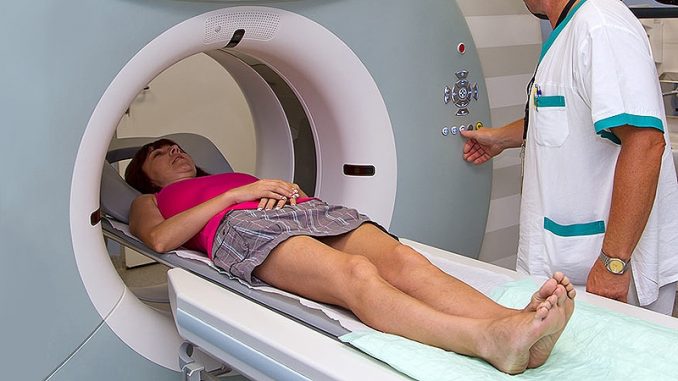
To diagnose multiple sclerosis (MS), the central vein sign (CVS) on brain MRI appears to work as well as oligoclonal bands (OCBs) in cerebrospinal fluid (CSF), and combining the two biomarkers yields the highest predictive value for MS, a new study indicates.
The presence of OCBs is “very specific for MS and is obtained by lumbar puncture, which is invasive and can be unpleasant, so it’s not an ideal test,” study investigator Daniel Ontaneda, MD, PhD, with the Mellen Center for MS Treatment and Research at the Cleveland Clinic, in Ohio, told Medscape Medical News.
In a pilot study, CVS was “highly correlated with the presence of OCBs and in many cases could serve to prove that a person has MS without the need for a spinal tap,” Ontaneda said.
The study was presented at the 38th Congress of the European Committee for Treatment and Research in Multiple Sclerosis (ECTRIMS) 2022.
Reducing the Need for Lumbar Puncture
OCBs in CSF are commonly used as a diagnostic biomarker for MS and can serve to meet the requirement for dissemination in time in the 2017 McDonald criteria.
CVS is an emerging neuroimaging biomarker for MS that may improve diagnostic accuracy and reduce the need for lumbar puncture.
For the study, the investigators compared the sensitivity, specificity, and positive predictive value (PPV) of CVS on MRI with that of OCBs in CSF for MS diagnosis.
Among the 53 participants, 24 (45%) met 2017 McDonald criteria for dissemination in space and time at baseline, and 27 (51%) met the criteria at 12-month follow-up.
At initial presentation, sensitivity for MS diagnosis was 75% for OCBs, 83% for CVS “Select-3” (3 CVS positive lesions per scan), and 71% for CVS “Select-6” (6 CVS positive lesions per scan).
The point estimate of sensitivity of CVS was higher than of OCBs, but there was no significant difference in sensitivities across methods.
Specificity at initial presentation was 76% for OCBs, 48% for Select-3, and 86% for Select-6.
The presence of OCBs was more specific than Select-3 for diagnosis of MS at initial presentation (P = .03), as was Select-6 (P = .001). There was no significant difference when comparing CSF OCBs with CVS Select-6.
At 12-month follow-up, the PPV was 84% for OCBs and 95% for Select-6; combining OCBs and Select-6 gave a PPV of 100%.
Ontaneda told Medscape Medical News that on the basis of these promising pilot data, the researchers have secured funding from the National Institutes of Health (NIH) for a prospective study to further investigate CVS as a potential biomarker for MS.
He also said there is “active discussion as to whether central vein sign should be added to the diagnostic criteria for MS.
“We think that it’s probably about time that we have diagnostic biomarkers that are sensitive and specific and can help us do away with complicated criteria to make the diagnosis, in favor of an imaging biomarker,” Ontaneda told Medscape Medical News.
A Green Light for Further Research
Commenting on the study for Medscape Medical News, Shaheen Lakhan, MD, a neurologist and researcher from Boston, Massachusetts, said, that “if an imaging finding on an otherwise routinely done MRI for patients with MS is just as good as analyses from the fluid from a spinal tap, of course, neurologists, and for sure patients, would go for the former.
“However, this study doesn’t fully support that argument just yet. It is retrospective with a tiny sample size, and the full way they standardized assessments and reporting haven’t been fully reported,” said Lakhan, who wasn’t involved in the study.
The study does, however, offer a “solid signal to green-light further exploration of a noninvasive assessment that may replace the dreaded spinal tap.
“In general, these principles need to be applied to all our invasive diagnostic criteria from biopsies to risky procedures, and also the incorporation of artificial intelligence/machine learning to aid in standardizing and scaling these assessments – and, frankly, reduce human error in readings,” said Lakhan.
Funding for the study was provided by the Race to Erase MS Foundation and the NIH. Ontaneda has received research support from the NIH, the National MS Society, the Patient Centered Outcomes Research Institute, the Race to Erase MS Foundation, Genentech, Sanofi, and Novartis and has consulted for Biogen, Genentech, Sanofi, Janssen, Novartis, and Merck. Lakhan has disclosed no relevant financial relationships.
38th Congress of the European Committee for Treatment and Research in Multiple Sclerosis (ECTRIMS) 2022: Abstract P185. Presented October 26, 2022.
For more Medscape Neurology news, join us on Facebook and Twitter.
Source: Read Full Article